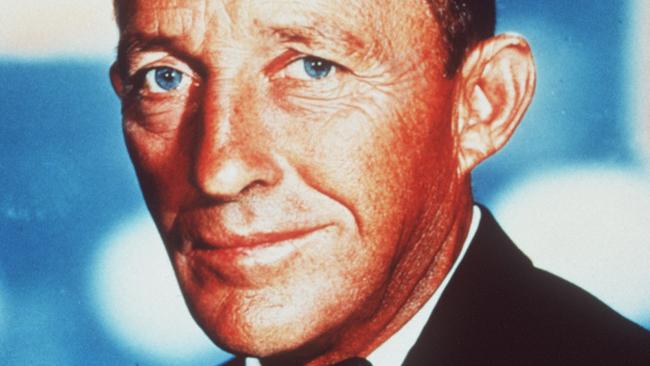Do You Hear What I Hear: classic born out of fear of nuclear war
Bing Crosby’s Do You Hear What I Hear was a classic of the Cold War.

Husband and wife songwriting team Noel Regney and Gloria Shayne Baker were hot properties in the early 1960s. Between them they wrote songs recorded by the likes of Jo Stafford, Doris Day, Marlene Dietrich and Eddie Fisher.
Among the songs they wrote were Rain, Rain Go Away, a hit for Bobby Vinton, and Goodbye Cruel World for James Darren, both in 1961.
Regney would go on to write the English words for Dominique, the French-language version of which was a No 1 record in 1962 for the ill-fated Belgian Jeanne Deckers, a woman most of the world knew only as the Singing Nun.
In October 1962 the pair was invited to write the B-side of a Christmas single to be recorded by the Harry Simeone Chorale. Simeone had arranged (and received an undeserved co-writing credit for) The Little Drummer Boy a few years earlier. It had been a huge seller and the record company wanted a follow-up.
It was a week unlike any other: in response to the previous year’s failed CIA-orchestrated Bay of Pigs invasion that hoped to overthrow Fidel Castro, Soviet leader Nikita Khrushchev placed nuclear missiles on Cuba, just 140km from Florida.
The Cold War had suddenly thawed. A defiant US president John F. Kennedy blockaded the island nation and demanded the weapons be decommissioned. His joint chiefs of staff wanted a full-scale invasion.
Kennedy’s televised address to his nation — and Khrushchev’s militant response — effectively put the superpowers on a war footing. The world held its breath.
Regney knew all about the horror of war. He’d been born in northern France and when his country was overrun by the Nazis he, like many others, was drafted into the German army. Risking all to stay in his German uniform while assisting his countrymen’s resistance, he led a party of German soldiers into a trap in which he was — presumably purposely — shot and injured while they were mown down around him.
Depressed at what appeared to be an imminent return to war, Regney walked the streets of New York wondering if he had it in him to write an upbeat Christmas song.
“En route to my home, I saw two mothers with their babies in strollers.,” he recalled years later. “The little angels were looking at each other and smiling. All of a sudden my mood was extraordinary.”
He looked at the newborns and imagined them as helpless lambs not even stained by original sin.
His first language was not English. Usually his wife wrote the words and Regney the music. But words — in English — came to him:
Said the night wind to the little lamb, do you see what I see?
Way up in the sky, little lamb, do you see what I see?
A star, a star, dancing in the night with a tail as big as a kite.
It was an ode for peace with a vision of an apocalypse. For “stars” read rockets with blazing tails on their way to the US east coast — and return fire aimed at Cuba. In the early years of the nuclear age this scenario was known as mutually assured destruction: its acronym, MAD, said it all.
Once home, Regney wrote down these words and asked his wife to compose music for them, reversing their usual roles.
One of her daughters later recalled that Baker, too, had been struck by inspiration while walking in the city. “My mother heard trumpets playing the melody in her head,” she said.
So came together the constituent parts for the most successful Christmas song of the modern era.
The Harry Simeone Chorale single is reported to have sold 250,000 copies before that Christmas, but unaccountably did not appear on the Billboard chart.
The following year Bing Crosby recorded what must be considered the definitive version that has sold well ever since, helped by his performance of the song on that year’s Bob Hope Christmas television special.
The rollcall of those who have interpreted it since is as extraordinary as it is varied: Perry Como, Glen Campbell, Kenny G, Celine Dion, the Carpenters, Delta Goodrem, Gladys Knight, Bob Dylan, Andy Williams, Susan Boyle, Whitney Houston, Johnny Mathis and Mahalia Jackson.
Who knows how many of them understood its underlying message?
“Noel wrote a beautiful song,” his then wife later recalled, “and I wrote the music. We couldn’t sing it, though; it broke us up. We cried. Our little song broke us up. You must realise there was a threat of nuclear war at that time.”
Regney’s favourite version of the song was, reportedly, by Robert Goulet who, he believed, comprehended his words and consequently sang the command “pray for peace, people everywhere” with conviction.
There are those who believe Goulet sang You Light Up My Life at the 1978 Miss Universe contest with equal authority.
In 1985, Regney spoke to The New York Times about his greatest creation: “I am amazed that people can think they know the song — and not know it is a prayer for peace.”
Noel Regney died on November 22, 2002, the 39th anniversary of the assassination of JFK. His famous song was performed at his funeral.
A hundred years from now they probably will be singing Do You Hear What I Hear as a Christmas standard; whether anyone by then will link the song to the assassinated president remains to be seen.



